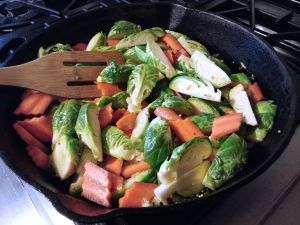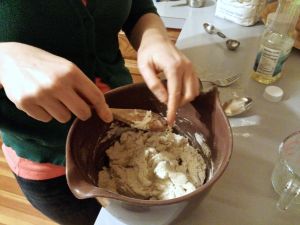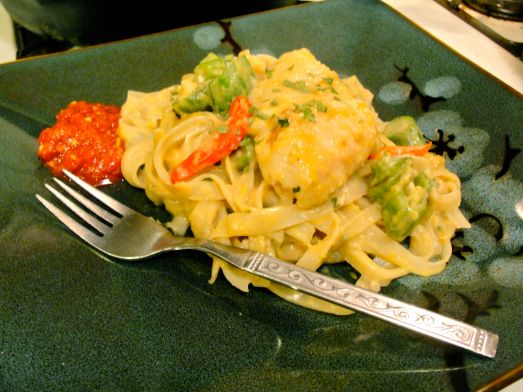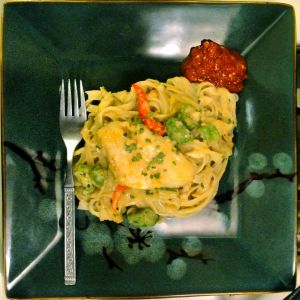
Coconut-crusted swordfish steak with dragon fruit slaw and jasmine rice.
Tonight we made a curiously medieval seeming meal with swords and dragons. We picked up some swordfish steaks and a dragon fruit with the notion of preparing fish with a fruit salsa, but the latter ended up as a cabbage-based slaw instead – looking a bit like dice has been thrown in. :-)
Ingredients, for the slaw:
- red cabbage, 1/2 head, thinly sliced
- dragon fruit, 1, peeled and cubed
- spicy red peppers, e.g., jalapeño, 2-3, seeded
(I think these were Barker’s Hot Pepper, a.k.a. hot Anaheim.) - scallion, 1, chopped
- fresh orange juice, about 1/4 cup
- fresh lime juice, from 1/2 lime
- apple cider vinegar, to taste
- chopped cilantro leaf (we used dried)
- salt, to taste
Prepare the slaw much as you would any fresh cabbage and vinegar-based coleslaw. Wait until the end, though, to carefully stirring the cubed dragon fruit in, when your slaw has been otherwise prepared to your liking.

Some dragon fruit slaw ingredients.
Ingredients, for the swordfish steaks and sauce:
- swordfish steaks, 1 per person, thawed from frozen
- unsweetened, flaked coconut, about 1/2 cup
- salt
- freshly ground black pepper
- scallion, 1, white portion chopped, greens sliced for garnish
- fresh orange juice, about 1/2 cup
- corn starch
While the slaw sits for a while, salt and pepper the swordfish steaks and coat with flaked coconut. For the sauce, simply stir about a teaspoon of corn starch into the orange juice and set aside for after the fish has been cooked.

Coconut-crusted swordfish and sauce ingredients.
Add a few tablespoons of oil, e.g., canola, to a skillet heated medium to medium-high.

Pan-frying coconut-crusted swordfish steaks.
Pan-fry the swordfish steaks, about 4-5 minutes per side (for these that were about 1 inch thick), flipping them over just once.

Pan-frying coconut-crusted swordfish steaks.
Plate the steaks and keep them warm. Meanwhile, reducing the pan heat to medium-low and quickly sauté the whites of the scallion just lightly, combined with whatever coconut flakes remained in the pan. Next, immediately pour the orange juice and cornstarch mixture into the pan, stirring with the scallion and coconut until the sauce thickens.

Preparing the coconut orange scallion sauce.
Pour sauce over each of the swordfish steaks, top with scallion greens, and serve accompanied by the fruit slaw and perhaps also jasmine rice.
This was a tasty meal. I’ve not prepared swordfish steaks before, but they were quite nice topped with this simple coconut-scallion-orange sauce. Swordfish is substantial in texture and was nicely contrasted by the fresh, crisp, spicy, tart, sweet fruit and cabbage slaw. I bet it would go just as well with a fruit salsa instead.

Coconut-crusted swordfish steak with dragon fruit slaw and jasmine rice.
Update (March 10, 2016):
The leftovers, with some black beans and salsa added, made a great “sad desk lunch!”

Swordfish and dragon fruit burrito!
Here are some related recipes I consulted for ideas:






































